The Prohibitive Culture of Snitching New
Posted by Zachary Berman, Reed Timmer, Hannah Hennessy, Allie Calvert, and Tasha Alexander at Friday, May 22, 2015 6:44:03 PM CDT
In C.J. Pascoe’s article, she refers to a statistic that 93 percent of youth hear homophobic slurs occasionally and 51 percent hear them daily. These homophobic slurs shape masculine identities. Similarly, boys mock homosexual behavior. One of the most prominent behaviors deemed ‘homosexual and unmanly’ is snitching. Snitching means that you are unable to deal with problems on your own and rely on others to fix things for you. Boys are supposed to take care of themselves and not need their ‘mommies’ or teachers when things aren’t going well. Our group read several articles, watched a film, and watched other videos that relate to the prohibitive nature of snitching. In most cases, a child goes to an adult, or ‘snitches’, in search of help. We see that most often, they either are ignored or appropriate action isn’t taken. In this post, we seek to define the difference between ‘classic snitching’ and reporting behavior that is beyond a child’s control.
The story of William’s Doll was a controversial subject. It was portrayed to schoolchildren to show that it is okay for boys to have a doll. Although William’s dad encouraged sports, William still wanted a doll to call his own. After some time latter his grandma decided that William should have a doll because he wants to care for it and love it. Despite the criticism that his classmates gave him for wanting a doll, William still wanted a doll. In this situation, the grandma acted as the social justice. Grandma gave the doll to William, which brought the justice to William, as he wanted a doll. Grandma also talked to William’s dad, showing him that William wants a doll to care for, so that when William grows up and becomes a father, he will be a great father to his baby. At the end of this video, there is a different attitude towards the situation from his father and the kids from school that made fun of him. In this video and reading, snitching plays a role in how the kids treat William, and his reaction to their bullying. At the beginning of this video, only three kids mock him, but the next time the chorus comes around, more kids mock him. There must have been some snitching going on. At the end of the video when William is talking to his grandma, he tells her how much he wants a doll. William also tells her how all the kids to make fun of him for wanting a doll. This shows the correct type of snitching. He is doing to because he is getting bullied, not to cause harm to the other kids.
In the video, “Free to be… You and Me”, if you listen to the lyrics of the song, you can hear a cry for kids to be equal. The reading explains how fifth graders understand and feel inspired by these lyrics. The song alone brought social justice to classrooms everywhere and gave a sense of equality with students. One student said, “I’m only in the fifth grade but I feel I can understand these songs. They are so meaningful and sensitive.” These songs tried to give a greater sense of diversity among children and to show these children that they can grow and carry on these traits and stories.
There is a gender standard of socially acceptable behavior that is heavily influences children. Boys and men are supposed to work hard, play sports, provide for the family, be smart, make decisions, wear blue, and marry girls. Girls and women are supposed to like pink, play with dolls, stay at home, cook and clean, bare children, raise the family, have decisions made for them by men, and marry a man. All of these stereotypes of socially acceptable gender behaviors standardize children into being what they should be instead of letting children grow to their full potential and be themselves. William, viewed as a boy who wanted to play with girl toys, was seen as feminine and gay, rather than as practicing to be a good nurturing father. One way to potentially break this stereotype is making toy colors more gender neutral instead of Pepto-Bismol pink and baby blue.
Free to Be…You and Me, Second-Wave feminism, and 1970s American Children’s Culture featured a song called Free to Be… You and Me. The song promoted kids to be who they are. It said that it is okay for boys to play with dolls and for girls to have liberty. It began the second-wave feminism both by inspiring adults and initializing new ways to raise children to be themselves. The song also promoted diversity in children’s’ lives. No matter how similar two families can be, those same families are also very different, though not inferior. A portion of children’s book viewed girls and women in an insulting way. A girl called Albasically stated that it was okay to be less girly as a young girl because she will eventually grow up to be a reserved lady. Books like these are considered “social poison” in the article. A woman’s confidence, based on the traditional women, is blind to the opportunities and potential of the world. Free to be did not represent easy acceptance to the changes coming among us, it represented the fight and hard work to achieve the goals you desire. Just as freedom for any independence war did not come easily.
In the eyes of children, a snitch is a tattletale. It is someone telling on someone else for doing something bad even if it has no immediate affect on him or her. This has evolved into telling on someone for doing anything at all, even if it does directly involve him or her. A couple of consequences come from snitching: worse treatment from a bully, loss of trust, and exclusion. A child’s goal in life is acceptance. They want people to like them even if they have to sacrifice parts of who they are. They think being friends with bad people is better than not having friends.
Sometimes kids are scared to tell people what is actually going on because they are told that they are tattling or snitching, and that’s not what you’re supposed to do. Some people act like the kids don’t know what they’re talking about, are just having a few problems in school, and aren’t really getting bullied. We need to let the kids know that they do have people to talk to and that they can come to people that will help them with their problems. Kids should not have to face bullying alone.
In the movie Bully, the same kid picks on Cole every day. He has threatened to break his arm and even to kill him. One day, the teacher sees it happening and makes them both come and talk to her. The teacher has them to shake each other’s hand and apologize. Cole won’t do it because the bully is only doing what the teacher says because they are in front of her, not because he actually means it. Cole tried many times to get away from the kid and tell people about him. He has reported the bullying to the school and to the police and they tell him they will take care of it, but nothing happens and the kid still picks on him every day. The teachers and police don’t take Cole seriously. If a kid goes to an authority like a teacher or police officer for help, he or she should get help. If he doesn’t, it teaches them that they are in it alone and there is no one to go to when the problem gets even more serious.
A girl named Ja’meya in the movie tries to talk about how mean the kids are to her and how they pick on her every day, but no one would listen. Ja’meya decided to do something about it for herself by bringing a gun to school to get the kids that were picking on her to leave her alone. She had to spend a couple of months in a psychiatric hospital as a result. She should have never taken the gun to school, but it could have all been prevented if someone would have listened to her when she was trying to tell people about her problems. Sometimes kids are under so much pressure to fit in and make friends that they forget what the difference between right and wrong. In some cases, like Ja’meya’s, they can get so fed up with everything going on that they make rush and bad decisions because they have no one to talk to.
Another kid from the movie Bully, Tyler, got bullied so severely that he committed suicide. All of the teachers’ responses were that they couldn’t watch what every kid said or did. It is understandable that with so many kids, it is hard to ensure everyone is on their best behavior, but when the person has already had problems with kids bullying him, you need to make sure to watch them and make sure that they are okay. One time at school, there were two kids who ganged up on Tyler and beat him up. After he got beat up, the school officers that were there said that they couldn’t press charges because the boys who did it said nothing happened. The school officers knew that the bullying that was going on, and when it happened right in front of them, they did nothing and acted like it was normal for boys. There are many instances of bullying that happen on an everyday basis, but we often try to act like nothing is happening. It has gotten to the point that the only time we pay attention to bullying is when a child takes their life because of it. We need be proactive and do something about bullying before it gets to that point.
Alex, also in the movie Bully, has a hard time telling his parents what is going on at school and on the bus because he doesn’t have many friends. He doesn’t want the other kids to dislike him even more. He told his mom, “If you don’t think these people are my friends, then what friends do I have?” He has become the punching bag for all of his supposed friends and doesn’t want to tell anyone about it because then he might lose the “friends” that he has. His parents went in to talk to the principal and the principal told his mom that she rode the same bus, and the kids on the bus are “good as gold”. After having a meeting with Alex’s parents they decided to talk to the kids bullying Alex. They think just getting after the kids is going to stop the bullies, but it doesn’t. It’s part of the reason Alex didn’t want to tell his parents in the first place: He has told them before and the principal had a talk with a kid, but that was it and the kid continued to bully him. Kids need to be able to go to someone when they need help. They shouldn’t be scared to tell adults what is going on, and they should be able to tell them without it being considered snitching. We would never question an adult and would help them right away, so why are we making our children suffer?
In terms of a social justice approach, snitching is viewed by society as a negative thing from an outside partying getting involved in another group’s business. We can see why snitching is bad in many situations, and a lot of them are brought up in the article, “Boy Culture”. The author talks about how boys grow up by experiencing games and pastimes where there is often head to head hostile conflict. This is where boys begin to learn the basis of bullying and snitching. Little fights are deemed as “boys being boys”, yet they learn to realize which groups of kids are weaker. There may be kids strictly observing the conflict, and later tattle on those they don’t like to get them in trouble. This type of tattling gives teaches children that snitching is bad.
Boy Culture also went over the culture and adult authority aspect of a boy’s childhood. This goes well with our concept of the prohibitive culture of snitching. I think by learning about authority, especially from people boys in that situation respect such as their parents is a key role in gaining background information about snitching and realizing snitching’s consequences, along with other bad behavior. Also connecting it to bullying, once bullying begins and escalates to the point where someone needs to stop it, the party that is being bullied or a third party almost immediately will go and look for a proper authority figure or party. If this aspect of boy culture (one of learning respect and almost a little fear for elders) is not learned, then the bully will have less of a chance to discontinue all the pain that he or she is causing. Going further, if that respect isn’t learned or realized then kids in the bullying situation will not know who to turn to for help, which is indeed different than snitching.
The last section in the “Boy Culture” article talked about friendship between boys. Friendship is key in building trust. They learn how to respect others. When snitching occurs, it obviously affects the feelings of the other party involved. If that aspect of a boy’s life doesn’t develop, they won’t realize the harm of snitching to others, and won’t be able to form bonds with others. The article talks about loyalty, which is a great word that relates to snitching and boys growing up. Remaining loyal to a friend or peer goes a long way. Loyalty shows maturity, even in a young boy, along with respect that they will carry for the rest of their lives. They will act with those aspects of their character when they get involved with a bullying situation.
These articles and videos all show ineffective adult intervention. However, proper adult intervention can help reduce or even eliminate bullying. Classmates are on the same relative level of wisdom and respect in society, while adults are more respected. According to NoBullying.com, only 20-30 percent of bullied students tell adults. Also, when an adult intervenes, the bullying stops within ten seconds about 57 percent of the time. The fact that adult intervention usually stops immediate bullying activity is important, but adults need to do more than just intervene. They need to help find a long-term solution that will less likely lead to the children reverting back to their old behavior. Society discourages snitches and tattle-tails, but often times the only way to resolve a problem is adult intervention. Thus, adults should make themselves an open resource to come to when kids are having problems. Them, they can determine whether or not it is worth action, but they must consider whether or not it can be solved without an adult to garner respect and authority.
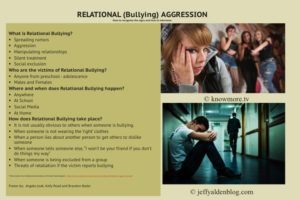 Kelly Read, Angela Leak, Brandon Bader
Kelly Read, Angela Leak, Brandon Bader








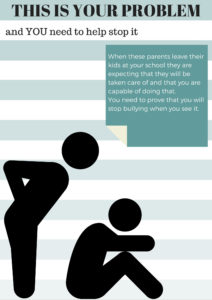
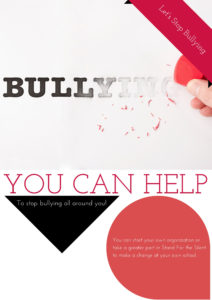
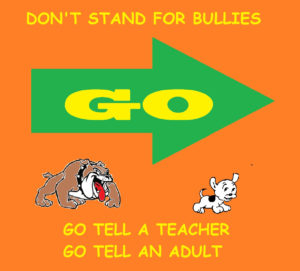


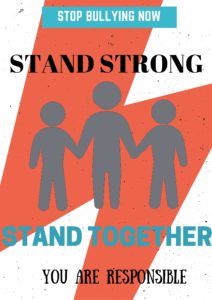
Recent Comments